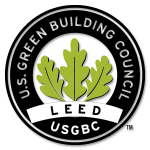Eco-Dores Monthly Bulletin
Sustainable building practices reduce environmental impact of campus facilities
The Eco-Dores peer residential education program is a collaborative effort between Vanderbilt-s Sustainability and Environmental Management Office (SEMO) and the Office of Housing and Residential Education (OHARE). In February, the Eco-Dores heard from Paul Marshall, architect for Campus Planning and Construction, about sustainable building practices on campus. Since Vanderbilt owns buildings for 100 years or more, it is in Vanderbilt-s best interest from both an environmental and financial perspective to incorporate principles of green building into construction projects.
 Vanderbilt University was the first university in the state of Tennessee to have any U.S. Green Building Council (USGBC) Leadership in Energy and Environmental Design (LEED) certified buildings on campus, an effort which was originally championed by VU students with the construction of the Martha Rivers Ingram Commons. The LEED Green Building Rating System is the nationally accepted benchmark for the design, construction and operation of high- performance green buildings. Organizations must apply for the certification, which is recognized as proof that a building is environmentally responsible, profitable and a healthy place to live and work. Today, Vanderbilt has a total of 11 LEED-certified buildings on main campus (1 basic, 5 silver, and 5 gold) which is one of the largest concentrations in the Southeast. LEED certified projects include:
Vanderbilt University was the first university in the state of Tennessee to have any U.S. Green Building Council (USGBC) Leadership in Energy and Environmental Design (LEED) certified buildings on campus, an effort which was originally championed by VU students with the construction of the Martha Rivers Ingram Commons. The LEED Green Building Rating System is the nationally accepted benchmark for the design, construction and operation of high- performance green buildings. Organizations must apply for the certification, which is recognized as proof that a building is environmentally responsible, profitable and a healthy place to live and work. Today, Vanderbilt has a total of 11 LEED-certified buildings on main campus (1 basic, 5 silver, and 5 gold) which is one of the largest concentrations in the Southeast. LEED certified projects include:
- Certified: Chef James Bistro
- Silver: Crawford House, Sutherland House, Gillette House, Benson Hall, Library Archives
- Gold: The Commons Center, Stambaugh House, Hank Ingram House, Murray House, General Library*
Several buildings constructed or renovated in years prior to Vanderbilt-s first pursuit of LEED certification also applied green building practices which are now included in LEED certification standards. Buildings such as the Student Life Center, Featheringill Hall, and Buttrick Hall were designed with environmentally-friendly features such as natural-light atria, low volatile organic compound (VOC) and recycled content materials, and water-conserving bathroom and efficient lighting fixtures.
An Example of Green Building: The Ingram Commons
The Ingram Commons (which is comprised of 5 new residences houses, 5 renovated residences houses, the Commons Center, and a new utility infrastructure and chiller plant) includes green elements such as regionally-sourced materials, reflective roofs, recycled glass, renewable bamboo floors, individual temperature controls in student rooms, energy efficient systems and equipment, natural daylight, pervious pavement, native landscaping, and ample green space.
Did you know?
- The Commons Center was built on the site of the old Hill Center, thus eliminating the consumption of virgin greenspace for this new construction. The patio outside of The Commons Center is composed of reused sandstone pavers that were once part of the Hill Center.
- The chairs in the upstairs dining area of The Commons Center were at one time years ago located in the Library.
- Post-consumer food waste material is reduced in volume by 85% and removed from the wastewater stream by a pulper installed in the dining operational area.
Future Sustainable Renovation and Construction
In Fall 2011, a green building resolution was passed by Vanderbilt Student Government (VSG), which states that the student body will advocate for the pursuit of the LEED Silver Certification for all new building projects exceeding $5 million in cost and will encourage the university to attain LEED certification in renovation and new building projects costing less than $5 million.
When completing future building projects on campus, Vanderbilt will utilize many of these successful design features that were incorporated in the Ingram Commons. Additional ways Campus Planning and Construction employs green building effectively include: use of reclaimed land, landfill diversion of a majority of the waste generated from demolition processes, reflective roof surfaces, and installation of water- and energy-conserving fixtures.
For more information about sustainable building at Vanderbilt, visit the SustainVU Green Building page. For more information about Eco-Dores, visit the Eco-Dores page or contact SEMO at SustainVU@vanderbilt.edu.
*Celebrate the LEED Gold Certification of the General Library Renovations with refreshments and tours of the recently renovated facility by the Library-s Green Team on Thursday, March 29 from 11:30 am to 1:30 pm in the 4th Floor Lobby. Wear green to the celebration to recognize the hard work of staff and students who have made this possible. A group photo will be taken at noon.
Leave a Response